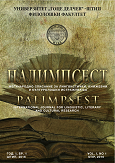VIRTUAL REALITY AS A METHOD OF PROMOTING ARCHITECTURAL CULTURAL HERITAGE AND CULTURAL MEMORY
Abstract
Virtual reality creates interactive audio-visual environments designed for multiple users. Virtual reality stems from industrial and military visual simulation, developed in the late 1980s, when it was applied to training simulations and supporting fast prototypes for industrial production. This paper explores the different methods of mixed reality, augmented reality and virtual reality, through examples of palaces in the urban core of Skopje and worldwide examples. Through the simulation methods that the mixed reality offers, the user is introduced into the simulation itself allowing for real interaction. The purpose of this paper is to emphasize the possibilities of virtual reality and its use as a medium for knowledge transfer and dissemination of cultural memory. Virtual legacy includes a range of functions facilitating synthesis, conservation, reproduction, digital processing and display of cultural evidence using advanced VR technologies. Digitization of Skopje's cultural heritage buildings from the early 20th century presents a digital method of reviving "captured" data and their interactive presentation. The focus of this paper is on architectural residential buildings, whose projects as part of Skopje's cultural heritage were created in the first half of the 20th century, objects that no longer exist due to the 1963 earthquake, and the revival of memory for them through various forms of digitalisation as virtual promotion.





